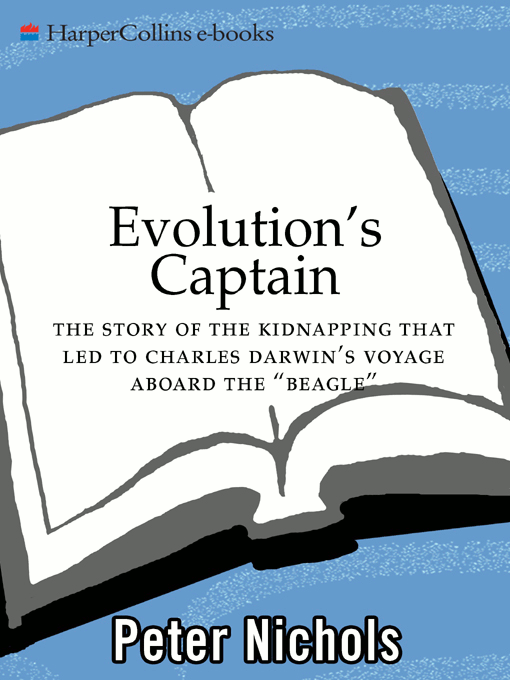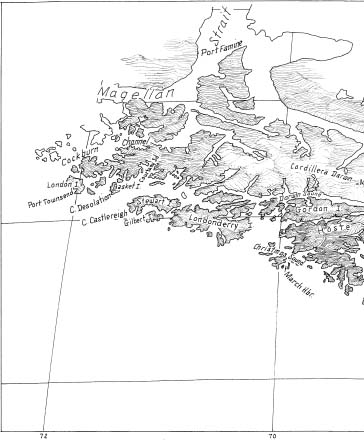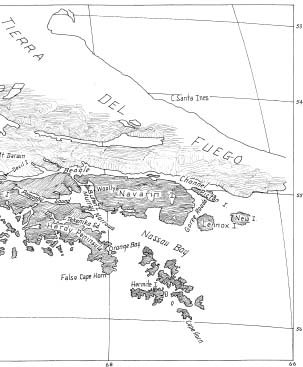Evolution's Captain
Read Evolution's Captain Online
Authors: Peter Nichols


The Story of
the Kidnapping
That Led to
Charles Darwin's
Voyage Aboard
the “Beagle”
ETER
N
ICHOLS

For Roberta
my ark, my evolution
But of the fruit of the tree which is in the midst of
the garden, God hath said, Ye shall not eat of it,
neither shall ye touch it, lest ye die.
And the serpent said unto the woman,
Ye shall not surely die:
For God doth know that in the day ye eat thereof,
then your eyes shall be opened;
and ye shall be as godsâ¦
âG
ENESIS
, 3: 3â5
Port Famine, Strait of Magellan, August 2, 1828. It isâ¦
In 1934, Nora Barlow, the granddaughter of Charles Darwin, visitedâ¦
In January 1829, HMS Adventure, with Captain King, HMS Beagle,â¦
Small wonder the job had driven Pringle Stokes mad.
FitzRoy has been characterized as going after the Fuegians whoâ¦
FitzRoyâs instructions from the British Admiralty contained no provisions aboutâ¦
The term “collecting” had a particular weight attached to itâ¦
Early in December 1830, Coxswain Bennett and the Beagle's recentâ¦
It was FitzRoy's man on the scene, Coxswain Bennett, installedâ¦
Perhaps only the dawn of the Internet, and the computerâ¦
Or so FitzRoy told Alexander Charles Wood, his cousin, aâ¦
Darwin traveled to Devonport by coach on October 24, 1831.
As the Beagle rolled and pitched across the Bay ofâ¦
They had come a remarkably long way. There was noâ¦
Nowhere are the designs of men more subject to theâ¦
Darwin was among the large group that set out onâ¦
A year and more into this second voyage aboard theâ¦
FitzRoy never counted on Admiralty support for his extracurricular hiringâ¦
Early voyagers called them the Enchanted Islands, but not becauseâ¦
The Beagle dropped anchor in Falmouth, England, on October 2,â¦
Sometime between coming home in October 1836 and finishing hisâ¦
The bookâin three volumes: King's, FitzRoy's, and Darwin's, with aâ¦
Religious mania was mainstream in nineteenth-century Britain. Almost as ifâ¦
Robert FitzRoy read of the massacre in the British pressâ¦
In October 1838â¦I happened to read for amusement Malthusâ¦
In late June 1860, FitzRoy traveled by train to Oxfordâ¦
Late in 1863, two years before FitzRoy's death, Reverend Whaitâ¦

P
ort Famine, Strait of Magellan, August 2, 1828. It is midwinter
at the bottom of the world. Snow drives at gale force across the small vessel at anchor. Daylight comes as a few gloomy hours of crepuscular dimness, and the afternoon is already growing dark. Four years later in this same anchorage, in this same vessel even, a young man of unusually sunny temperamentâthe twenty-four-year-old Charles Darwinâwill write in his journal: “I never saw a more cheerless prospect; the dusky woods, piebald with snow, were only indistinctly to be seen through an atmosphere composed of two thirds rain & one of fog; the rest, as an Irishman would say, was very cold unpleasant air.”
Alone in his cabin beneath the poop, the vessel's commander, a man still in his twenties, is in the last stage of despair. For him time has lost its swift flow; it has flattened into an unending, intolerable stasis. He sees no relief. He has been in these desolate waters for two years: years more stretch ahead. HomeâEngland, a place as distant as Earth from this cold Plutoâis beyond imagining, beyond regaining.
He raises to his head a small pocket pistol. He is certain of this now, eager for it, and his finger at last tugs with resolve on the trigger.
But there is still too much time: in the long second that
stretches between the release of the hammer, the spark of flint, the flash of powder, and the explosion that sends the ball on its path, his hand wavers, crucially.
Â
He was Captain Pringle Stokes; the vessel, HMS
Beagle
. It lay at
anchor in Port Famine with a larger ship, HMS
Adventure
. The two ships, under the overall command of Captain Phillip Parker King, had been dispatched by the British Admiralty in May 1826 to survey the southern coasts of South America, from Montevideo on the Atlantic to Chiloé Island in the Pacific. They were particularly instructed to map what they could of the still largely unknown seacoast of Tierra del Fuego, the desolate, tortuously labyrinthine southernmost tip of the drowned Andes.
The first passage from the Atlantic to the Pacific had been discovered by the Portuguese navigator Ferdinand Magellan, in 1520. He was looking, as was Columbus, as were they all, for that still elusive western route to the spice islands of the Indies. Columbus died in 1506, never knowing he had not found them. It was the Spaniard Vasco Núñez de Balboa who, on September 26, 1513, scaled a hilltop on the isthmus of Darien, in what is now Panama, and first saw the South Sea stretching away in limitless distance beyond Columbus's mistaken Orient. This information expanded the known circumference of the world by more than a third. Seven years later, Magellan, seeking access to that South Sea, found a wide, navigable passage between the bottom of the Americas and, below that to the south, a bleak Terra Incognita. His chronicler, Antonio Pigafetta, who sailed with him, recorded the discovery with an exultant pride:
We found by a miracle, a strait which we call the strait of the Eleven Thousand Virgins; this strait is a hundred and ten leagues long which are four hundred and forty miles, and almost as wide as less than half a league, and it issues into another sea which is called the Peaceful Sea; it is surrounded by
very great and high mountains covered with snow. I think there is not in the world a more beautiful country, or a better strait than this one.
Magellan's strait is actually 310 miles long from Atlantic to Pacific; but in the weeks they took to pass through it, Magellan and the four ships in his small fleet probably sailed five times that distance. To port, to the south as they tacked endlessly against westerly winds, they saw signs of natives in the dim fires and smoke on the shores of Terra Incognita. Much later, back in Spain, in accounts of the voyage, the land on this southern shore of the strait became known as Tierra del Fuego, Land of Fire.
The only other route from the Atlantic into the Pacific, the open sea passage around a rock mistaken for the southerly cape of Tierra del Fuego, discovered in 1616 by the Dutch captain Willem Schouten of Hoorn, was an exposed and awful place. There, icy winds blast at hurricane force down the glaciers of the Andes, and freak waves driven by westerly winds unimpeded around the bottom of the globe meet off Schouten's false cape in a nightmare maelstrom that was and remains a desperate place for any vessel. Seeking a fast passage to Tahiti in 1788, William Bligh tried to force his ship, HMS
Bounty
, past this Cape Horn. He spent over a month tacking back and forth, making only a handful of miles to westward in all that time. He, and more especially his crew, became so demoralized that he turned around and sailed the other way to Tahiti, eastward around a good part of the world, just to have the winds at his back.
Bligh knew too little about the twisting Strait of Magellan immediately to his north to force his ship through it with a fractious crew. Forty years later, blizzard-bound on its northern shore, the
Adventure
and the
Beagle
were attempting to chart a safe passage through the strait, to find a less forbidding route for ships passing between the Atlantic and the Pacific.
Â
Though neither their commanders nor the lords of the Admiralty
who had penned their orders saw them as such, the two ships anchored in Port Famine were part of the grandest design of historyâso audacious that not until it was in place was it truly seen by those who had made it. In this year of 1828, the British East India Company had been flourishing for two centuries; the Raj, a deeply entrenched and structured community of 50,000 British soldiers, merchants, and their families, controlled 90 million inhabitants in India, the biggest, proudest, most ostentatious foreign possession of the suddenly
Great
Britain. But even before the chubby eighteen-year-old Victoria acceded to the throne in 1837, British interests around the world were acquiring the solidity and permanence of the railway network and its massive gothic stations that were being built at home.
Simple geography suggested what was soon to happen: In the sugar islands of the Caribbean, in the Canadian Arctic, at the Cape of Good Hope, in Singapore and Penang and Bermuda, in British Honduras and British Guiana, in Gibraltar and the Falkland Islands, Mauritius, Ceylon, Hong Kong, Australia and New Zealand, on the coasts of East and West Africa, and pushing into its continental heart, the British were taking control, subjugating the natives, settling, sowing, mining, and taking away whatever could be used at home or traded for something elsewhere. They brought God and moral certainty with them, and a rigidly hierarchical society into which, in servile positions, the locals everywhere fit perfectly. They had staffed these outposts, or “stations”âlittle Englands landscaped, groomed, and tidied to resemble homeâwith over a million Britons. They were defended, and communication between them was ensured, by the armies and navies that had so recently defeated Napoleon and become the greatest war machine on Earth. All these far-flung trading stations were, for a time, simply British “interests” abroad.
But they could not remain so. Power does not hover at a flatline: It must be protected and fortified; it must grow, exponentially,
or collapse. There could never be enough tea, diamonds, ivory, gold, cotton, and lumber; eventually mere supremacy and influence would no longer suffice. With the Industrial Revolution's starburst of refinement in the sciences of steam and ironmaking, with improvements in transportation and mining and manufacturing and the building of tunnels and bridges and railways, alloyed with the inexhaustible abundance of cheap native labor, Britain's engineers, merchants, and emissaries of government swarmed over the earth, protected and boosted by the might of British power and moral sovereignty. And long before anyone imagined or wanted such a thing, the little island nation found itself possessed of an empire, on a fabulous and unprecedented scale, and it seemed right and natural. Back home in England, mapmakers and printers of atlases agreed on a certain pastel pink to delineate these possessions, and Englishmen spinning their globes in paneled clubrooms could follow beneath the glossy lacquer a swath of pink geography so completely encircling the earth that, one saw immediately, the sun never set on the British Empire.
A sea passage through the Americas, between east and west, was obviously an integral and necessary part of such a design. (A canal cut through the mountainous isthmus of Central America had been suggested by a priest, Francisco López de Gómera, as long ago as 1552, but three centuries later this was still a remote possibility.) The few existing charts of the southern coasts, made by Magellan, Sarmiento, Schouten, and others, were inaccurate, inadequate, and worrisome: others would come wanting to fill in the blanks. In the early nineteenth century, the continent of South America tantalizingly resembled a second Africa, but it was far less known and still largely unpenetrated. The wealth of its minerals and resourcesâEl Dorado and all that Inca gold that had inflamed the fancies of the Spanish conquistadoresâcould still only be guessed at. The influence of Spain had dwindled, leaving the way open for the courtship of Latin America's nascent coastal states by France and the newly autonomous
North American union. Apart from the Arctic and the Antarctic, which had only been distantly seen and guessed at by explorers such as Cook, the bottom of South America was as unknown as any place on Earthâremoter and more unexplored by Europeans than Africa or Borneo. As a gateway between the oceans, and a site of strategic importance, this continental extremity was unique. An accurate charting of the South American coasts was imperative. This would reveal harbors of refuge, military potential, and any alternative passages to Cape Horn and the Strait of Magellan. It would mean control and influence over more, history instructed, than could be imagined.
Â
The two ships made their headquarters at Port Famine, roughly
halfway through Magellan's strait. The port's name describes the fate of the harbor's first European inhabitants. They were put ashore in 1584 by the Spanish navigator Pedro Sarmiento, in an attempt to establish a Spanish colony, which Sarmiento named San Felipe, after his king. In the summer of 1584, it seemed a promising place: then as now a natural harbor, easy to sail in and out of, well protected from prevailing winds, with a good range of depth for all sorts of vessels, a bottom that provided good holding for anchors in clay and sand. There were convenient landing places ashore, and thickly wooded hillsides offered timber for fuel and building. But when winter came, Sarmiento's settlers starved and froze. The few survivors were rescued by a passing English ship, whose captain, Thomas Cavendish, gave the place a name that stuck. Today part of Chile, it is called Puerto del Hambre, Port of Hunger.
Captain Phillip Parker King was aware of the place's grim history, but the
Adventure
and the
Beagle
were well stocked with food and equipment, and he chose to make Port Famine, with all the advantages it offered, the base for their operations. He split the territory to be surveyed in two. He took
Adventure
east and
south and sent Captain Pringle Stokes and the
Beagle
west, up the narrowing strait toward the wilder, more labyrinthine Pacific shore, into the area of greater blanks on their maps. Stokes sailed, literally, off the charts.
Our twenty-first century satellite-corrected atlases reveal the land here as a maze of mountain-sized, long-limbed Rorschach blots, between and through which course sizable crumbs of glacier ice and seawater driven by storms and ferocious tidal streams. Today's sailors navigate these waters with satellite-enabled handheld GPS receivers. If they are exposed on deck, their heads are wrapped in fleece hats, tucked inside Gore-Tex hoods. Eyes dart between digital readouts and views of cloud-hung sounds and fjords, each one resembling the next. It is almost impossible to imagine how one would proceed without this miraculous technology, without a diesel engine throwing a big-bladed propeller, without central heating and the space-age clothes that keep a sailor warm and, above all, dry.
Before the global positioning system (GPS) had been created, the few seafarers venturing here sailed chart in hand, marking off each headland, each rock, as one would find a route with a Baedecker through Budapest at night in fog. But even then the weather, obscuring and revealing the poorly glimpsed tumbling, haphazard land, distorting its apparent size and distance, could confuse the most careful navigator. Stokes too had charts, early Spanish editions, and those drawn by the English navigator Sir John Narborough, which were little better than the ancient vellums on which priests had marked the inferences of Hades. The most sophisticated navigational devices of his age, sextant and chronometer, depended on sighting the sun or the moon or the stars, and this, beneath the unceasing roll of storms that came off the Southern Ocean, was rarely possible. In effect, Stokes pushed the tubby square-rigged
Beagle
through fog while negotiating hurricanes.
For three months, from February to April 1827, the
Beagle
explored the western reaches of the Strait of Magellan. Charting the serrated coast in an unbroken line was an impossible ambition, not even attempted. (A modern chart, corrected to the year 2001, shows large areas of coastline in the western part of the strait marked with dotted lines, indicating even now the uncertainty of contour. It bears the written warning: “Owing to the incomplete nature of the surveys this chart should be used with caution.”) What Stokes did attempt was the accurate plotting of points crucial to navigators. Within a mile or two of where they are shown on a chart today, he fixed the latitude and longitude of Cape Victory, actually a narrow islet, and Cape Pillar, the tip of Desolation Island, which together define the western entry to the Strait of Magellan, and between them a visible but hazardous scattering of rocks called, by the Spanish, the Evangelists. The fixing of these points, and a few bays and anchorages, with comments on what might be of use in them to passing ships, were the results of these months of perilous navigation. Stokes's main accomplishment each day was preventing the loss of his ship. This was a constant danger, and many times appeared likely, and the toll on the man responsible was deeper than even he knew at the time. Finally, in April, he turned his ship downwind at last and headed back to rendezvous with the
Adventure
in Port Famine. From there the two ships sailed north to Montevideo and Rio de Janeiro, where they spent the southern winter and replenished their stores.


